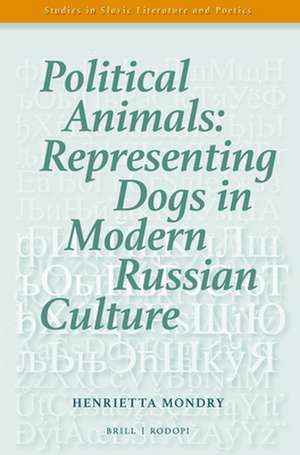Political Animals: Representing Dogs in Modern Russian Culture: Studies in Slavic Literature and Poetics, cartea 59
Autor Henrietta Mondryen Limba Engleză Paperback – 4 feb 2015
Preț: 559.76 lei
Preț vechi: 682.63 lei
-18% Nou
Puncte Express: 840
Preț estimativ în valută:
107.11€ • 112.21$ • 88.77£
107.11€ • 112.21$ • 88.77£
Carte indisponibilă temporar
Doresc să fiu notificat când acest titlu va fi disponibil:
Se trimite...
Preluare comenzi: 021 569.72.76
Specificații
ISBN-13: 9789042039025
ISBN-10: 9042039027
Dimensiuni: 155 x 235 mm
Greutate: 0.68 kg
Editura: Brill
Colecția Brill
Seria Studies in Slavic Literature and Poetics
ISBN-10: 9042039027
Dimensiuni: 155 x 235 mm
Greutate: 0.68 kg
Editura: Brill
Colecția Brill
Seria Studies in Slavic Literature and Poetics
Recenzii
“This study is provocative, as it should be given the transgressive nature of animal studies and the range of material addressed. It will especially reward readers who are interested in cultural studies, Russian literature and history, and animal studies.” – Ian Helfant, Colgate University, USA, in: Slavic Review 75.1 (2016)
“[...] this book is an illuminating investigation of an important aspect of Russian culture, providing thought-provoking hermeneutic studies and showing up striking continuities.” – Kevin Windle, Australian National University, in: The Russian Review Spring 2016, pp.150-151
“Henrietta Mondry’s book is obviously a labour of love. She has done a tremendous amount of research, as is reflected in her analyses, footnotes and bibliography. […] The territory explored includes, among others, pagan and Christian beliefs about dogs; information about attitudes toward dogs and other animals in Russian and other cultures; approaches to the role of dogs in Russian literature and culture, primarily nineteenth and twentieth century, although there is some discussion of pre-nineteenth-century (the dog heads on the saddles of Ivan the Terrible’s oprichniki, and Krylov, for example) and twenty-first century images; Buddhism; antisemitism; children’s literature; animal training practices; conjectures about the link of some of the material discussed to Nikolai Fedorov’s ideas; Pavlov’s experiments on dogs; statues in honour of Laika, the first dog in space; and science fiction. Specific works discussed include those by obscure writers and those of well-known writers such as Gogol´, Turgenev, Dostoevskii, Chekhov, Remizov, Maiakovskii, Zamiatin, Bulgakov, Shalamov, Vladimov and Pelevin.” - Ellen Chances, Princeton University, in: SEER 94.2 (2016), pp. 330-331
"With the daring assertion that the dog outranks the bear as Russia’s primary symbolic animal, Henrietta Mondry opens this intriguing study of canine symbolism since the early nineteenth century. By unpacking the dog’s changing roles (primarily in literary fiction, but also in cinema), she reveals both historical shifts in the treatment of animals and cultural tensions sublimated in furry form. In literalizing the literary ‘underdog’, Mondry draws on an entire subculture of scholarship, from studies of animal rights and ‘speciesism’ by John Simons and Peter Singer to specifically Russian essays by Amy Nelson, Jane Costlow, and others." - Muireann Maguire, University of Exeter, in: Modern Language Review 111.4 (2016), pp. 1165-66
“L’ouvrage [...] représente une contribution non négligeable á une vaste entreprise comparative qui ne fait que débuter, sur la place des anumaux et tout particuliérement du chien dans les pratiques et les représentations des différentes sociétés et cultures humaines.” – Jean-Pierre Digard, in: L’homme, vol. 217 (2016), pp.172-174
“[...] this book is an illuminating investigation of an important aspect of Russian culture, providing thought-provoking hermeneutic studies and showing up striking continuities.” – Kevin Windle, Australian National University, in: The Russian Review Spring 2016, pp.150-151
“Henrietta Mondry’s book is obviously a labour of love. She has done a tremendous amount of research, as is reflected in her analyses, footnotes and bibliography. […] The territory explored includes, among others, pagan and Christian beliefs about dogs; information about attitudes toward dogs and other animals in Russian and other cultures; approaches to the role of dogs in Russian literature and culture, primarily nineteenth and twentieth century, although there is some discussion of pre-nineteenth-century (the dog heads on the saddles of Ivan the Terrible’s oprichniki, and Krylov, for example) and twenty-first century images; Buddhism; antisemitism; children’s literature; animal training practices; conjectures about the link of some of the material discussed to Nikolai Fedorov’s ideas; Pavlov’s experiments on dogs; statues in honour of Laika, the first dog in space; and science fiction. Specific works discussed include those by obscure writers and those of well-known writers such as Gogol´, Turgenev, Dostoevskii, Chekhov, Remizov, Maiakovskii, Zamiatin, Bulgakov, Shalamov, Vladimov and Pelevin.” - Ellen Chances, Princeton University, in: SEER 94.2 (2016), pp. 330-331
"With the daring assertion that the dog outranks the bear as Russia’s primary symbolic animal, Henrietta Mondry opens this intriguing study of canine symbolism since the early nineteenth century. By unpacking the dog’s changing roles (primarily in literary fiction, but also in cinema), she reveals both historical shifts in the treatment of animals and cultural tensions sublimated in furry form. In literalizing the literary ‘underdog’, Mondry draws on an entire subculture of scholarship, from studies of animal rights and ‘speciesism’ by John Simons and Peter Singer to specifically Russian essays by Amy Nelson, Jane Costlow, and others." - Muireann Maguire, University of Exeter, in: Modern Language Review 111.4 (2016), pp. 1165-66
“L’ouvrage [...] représente une contribution non négligeable á une vaste entreprise comparative qui ne fait que débuter, sur la place des anumaux et tout particuliérement du chien dans les pratiques et les représentations des différentes sociétés et cultures humaines.” – Jean-Pierre Digard, in: L’homme, vol. 217 (2016), pp.172-174









